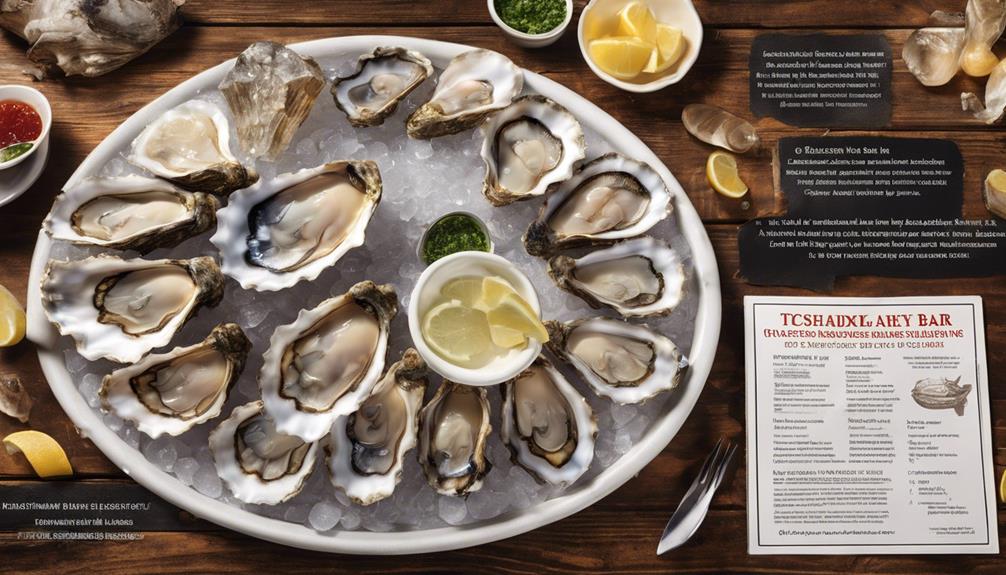When serving raw oysters, it is crucial to adhere to the five essential requirements. This includes following food safety regulations, displaying risk messages, and adhering to labeling guidelines for pre-packaged oysters. Proper storage and serving temperatures, along with clear consumer advisory statements and allergen information, are vital safety measures. Monitoring red tide, disseminating health warnings, and complying with FDA recommendations are crucial for ensuring consumer safety and well-being. Enhancing your understanding of raw oyster serving practices through learning more about these key requirements is important.
Key Takeaways
- Compliance with essential food safety regulations is paramount.
- Clear display of mandatory risk messages for consumer awareness.
- Proper labeling on pre-packaged raw oysters is mandatory.
- Regular monitoring and compliance with safety measures are crucial.
- Importance of adhering to FDA recommendations for safe handling.
Regulatory Compliance
What're the essential regulatory compliance requirements for serving raw oysters?
When it comes to serving raw oysters, there are vital food safety regulations that establishments must adhere to. One of the key requirements is the display of mandatory risk messages to inform consumers about potential foodborne illness risks associated with consuming raw oysters. These warnings are especially important for individuals with specific medical conditions that may be more susceptible to such risks.
Additionally, establishments serving raw oysters need to make sure that pre-packaged raw oysters and unshucked raw oyster containers meet specific labeling requirements. This helps in providing clear information to consumers about the product they're purchasing and consuming.
Furthermore, there's a process for exemptions available for establishments serving molluscan shellfish with reduced bacteria levels, but this requires approval from the state health officer. It's essential for establishments to comply with these regulatory requirements to prioritize consumer safety and well-being.
Safety Measures Implementation

Implementing safety measures when serving raw oysters is essential for ensuring consumer well-being and compliance with food safety regulations. To minimize risk and promote health at a food establishment, here are four essential safety measures that must be implemented:
- Hand Washing: Regular and thorough hand washing is important before handling raw oysters to prevent the spread of bacteria and contaminants.
- Proper Temperature: Raw oysters must be stored and served at the appropriate temperature to inhibit bacterial growth and guarantee food safety.
- Consumer Advisory Statement: A clear warning about the risks of consuming raw oysters should be displayed to inform customers about potential health hazards.
- Allergen Information: Proper labeling of allergen information for dishes containing raw oysters is necessary to protect individuals with food allergies.
Red Tide Monitoring
Regulatory agencies actively monitor red tide blooms in coastal waters to safeguard shellfish and consumer health. Red tide, a natural phenomenon caused by algal blooms, can produce toxins harmful to shellfish. This poses a risk to consumers if contaminated shellfish are consumed.
To guarantee safety, shellfish harvesting is restricted in areas affected by red tide until toxin levels decrease to safe levels. Ongoing monitoring of red tide is essential for the safety of shellfish products available in the market.
Consumers should stay informed about red tide alerts in their area, especially when consuming raw oysters, to avoid any potential health risks associated with toxin-contaminated shellfish. By staying updated on red tide monitoring efforts and safety alerts, consumers can make informed decisions about consuming shellfish, promoting a safer dining experience for everyone involved.
Health Warnings Dissemination

Health warnings are an essential component of ensuring consumer safety when serving raw oysters. When it comes to raw shellfish, especially raw oysters, public health is a top priority. Here are four key points to consider regarding health warnings dissemination in food service establishments:
- Risk Awareness: Health warnings inform consumers about the risk of foodborne illnesses associated with consuming raw oysters.
- Protecting Vulnerable Individuals: These warnings are critical for individuals with certain medical conditions, informing them about the dangers of consuming raw shellfish.
- Legal Requirement: Disseminating health warnings is a legal obligation for food service establishments to uphold transparency and guarantee consumer safety.
- Prevention of Illness: By educating customers about the risks associated with raw oysters, establishments play a crucial role in preventing foodborne illnesses and promoting public health.
Ensuring that health warnings are prominently displayed is essential for maintaining a safe dining experience for all patrons.
FDA Recommendations Compliance
Following FDA recommendations is vital for ensuring the safe handling and serving of raw oysters in food establishments. Restaurants must adhere to these guidelines to minimize the risk associated with consuming molluscan shellfish served raw. Compliance with FDA recommendations is essential to prevent undercooked oysters from causing foodborne illnesses. Below is a table summarizing key points establishments must consider to meet FDA standards:
| FDA Recommendations Compliance | |||
|---|---|---|---|
| Requirement | Description | Importance | Action |
| Display Consumer Advisory | Warn about risks | High | Implement signage |
| Allergen Information | Label on menus | Medium | Ensure clear labeling |
| Food Safety Plan | Manage risks | High | Develop and implement plan |
| Maintain Logs | Temperature, tags, illness | High | Keep records for 90 days |
Restaurants must follow these guidelines diligently to provide a safe dining experience for customers and protect against potential health hazards associated with raw oyster consumption.
Frequently Asked Questions
What Must a Food Establishment That Serves Raw Oysters Have?
As a food establishment serving raw oysters, I must guarantee proper risk messages, allergen labeling, sanitation plans, shellstock tag retention, and compliance with health regulations. These requirements help maintain food safety and protect consumers.
What Do You Need to Serve Oysters?
To serve oysters, you'll need a keen eye for freshness, proper labeling, a solid food safety plan, and state health officer approval. It's crucial to prioritize consumer safety and maintain strict sanitation practices.
What Is the Rule for Eating Raw Oysters?
Eating raw oysters comes with risks, so it's important to be aware of potential health hazards associated with consumption. Ensuring clear warnings on menus and complying with state regulations is essential for safe dining experiences.
How Do You Serve Raw Oysters at a Party?
I serve raw oysters at a party by nestling them on a bed of crushed ice, offering zesty lemon wedges, tangy cocktail sauce, and delicate oyster forks. Guests savor Blue Point, Kumamoto, and Gulf oysters with hot sauce and mignonette.
Are Water, Fuel, Food, and Raw Materials Essential Requirements for Food Establishments Serving Raw Oysters?
Water, fuel, food examples and raw materials are essential for food establishments serving raw oysters. Quality water is crucial for cleaning and processing oysters, while fuel is needed to power kitchen equipment. Fresh food examples and raw materials are necessary to prepare and serve high-quality raw oysters to customers.
Conclusion
In summary, ensuring food establishments serving raw oysters meet regulatory requirements is vital for public health and safety. Implementing safety measures, monitoring red tide, disseminating health warnings, and complying with FDA recommendations are all essential steps.
Remember, it's better to be safe than sorry when it comes to enjoying these delicious delicacies. So, always prioritize precautions to prevent any shellfish surprises down the line.










